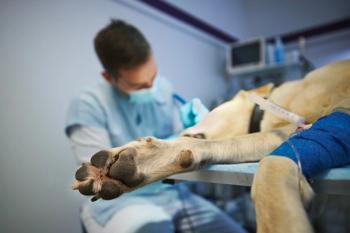
The deets on doggie dementia
A look at cognitive decline in the aging canine brain, including physiologic changes, clinical signs, diagnostic difficulties and current treatment recommendations and challenges for both veterinarians and pet owners.
annette shaff/stock.adobe.com
Hudson, a mixed-breed dog belonging to Cynthia Nickerson and her brother, Gabriel Gavrin-Savits began showing signs of cognitive decline around age 12. He behaved normally during the day, Nickerson says, but became disoriented and confused at night.
“He would pace around the house, going from room to room waking each of us up,” reports Nickerson, an accountant in Wilmington, North Carolina. “At first, we were able to reassure him and get him back to sleep. But after a while, nothing we did could help ease his distress.”
That's when Nickerson and Gavrin-Savrits reached out to their veterinarian, who, based on Hudson's behavior and other factors, diagnosed canine cognitive dysfunction (CCD).
What is CCD?
Commonly known as “doggy dementia” among pet owners, CCD is a neurodegenerative disorder characterized by behavioral changes and cognitive deficits. The most common clinical signs of CCD include disorientation, loss of social interaction, sleep disturbances, urinary and fecal incontinence, decreased activity and progressive loss of acquired memories. In this regard, CCD closely resembles Alzheimer's disease in humans, and this association has become a focal point in ongoing research into the syndrome in dogs.
Cognitive decline received little attention in veterinary circles until the 1990s, notes Elizabeth Head, MA, PhD, associate director for education at the University of Kentucky's Sanders Brown Center on Aging in Lexington. Among the first to write about the syndrome was William Ruehl, VMD, PhD, DACVP, who coauthored an early paper exploring the use of L-deprenyl (selegiline) to improve cognition in aging dogs.1
“As years went by and more data were collected, it turned out that just as in people, about a third of the dogs we tested were severely impaired-they couldn't remember information past a few seconds,” Dr. Head says. “That data led to veterinarians' understanding that this is a real physiologic degenerative process in the brain that can be distinguished from other health concerns in the older dog.”
Prevalence and risk factors
The prevalence of CCD is difficult to determine for a number of reasons. The literature suggests that around 15% of dogs over age 10 show signs of cognitive dysfunction, with the figure rising to 40% to 50% of dogs 14 years and older, according to Leontine Benedicenti, DVM, DACVIM, assistant professor of clinical neurology and neurosurgery at the University of Pennsylvania School of Veterinary Medicine in Philadelphia.2 Among cats, she says, signs of cognitive dysfunction are seen in about half of those 15 years or older.3
CCD was once believed to occur equally in all dog breeds, but recent research suggests that the syndrome may be more common among dogs that have been spayed or neutered.2,3 “These were small studies, so I don't know what kind of impact they will have,” Dr. Benedicenti says, “but they do suggest that certain hormones may have a protective effect against cognitive decline as dogs get older.”
There also is evidence that CCD may be more common among smaller, longer-lived breeds than in larger breeds, reports Natasha Olby, VetMB, PhD, MRCVS, DACVIM, professor of neurology/neurosurgery in the Department of Clinical Sciences at the North Carolina State University College of Veterinary Medicine in Raleigh.4 “We don't have a lot of data on this yet, but it's something we're looking at,” she says. “Giant breeds tend to have a shorter life span, and it's much less common that we'll get a consultation call about these dogs showing the classic signs of CCD. It's much more likely in older smaller breeds.”
Diagnostic difficulties
The pathology of CCD is similar to that of its counterpart in humans, Dr. Olby says. “There is gradual neuronal loss in the same areas of the brain that are affected in people with Alzheimer's disease, so you start to see the prefrontal and frontal cortex effects,” she notes. “We also see amyloid accumulation, but we do not see the same tau protein tangles that are seen in people.”
On magnetic resonance imaging, the brains of dogs with CCD appear smaller and atrophied, Dr. Olby adds. “There has been some nice work out of Japan that looked at measuring the different areas of the brain in dogs as they age,” she says.5 “The interthalamic adhesion-the region of the brain where the two hemispheres stick together-gets smaller and smaller as CCD worsens, reflecting the neuronal loss in the cortex.”
CCD can be difficult to diagnose because many other conditions found in aging dogs mimic its most common characteristics. “There are clinical signs that are commonly associated with the problem, but they are not specific to CCD,” explains Rod Bagley, DVM, DACVIM, professor and chair of veterinary clinical sciences at Iowa State University College of Veterinary Medicine in Ames. “Disorientation, for example, may be due to a lot of things, such as low blood sugar or vision problems; it doesn't have to be that the brain isn't processing.”
Changes in a dog's sleep cycle, another common characteristic of CCD, may also have other causes, Dr. Bagley continues. For example, some animals sleep at different time periods at different points in their life, so sleep cycle changes are not necessarily pathognomonic.
“That's always the problem in veterinary medicine compared with human medicine,” Dr. Bagley says. “I can ask you questions to find out if you are oriented to time and space. With animals, we must observe their behaviors and make inferences, and sometimes the inferences are not accurate.”
In the majority of cases, CCD requires a differential diagnosis that methodically eliminates other potential causes until only CCD remains. “It's a lot harder for clinicians to come to that diagnosis because right now it's a process of elimination,” says Dr. Head. It's much easier in the human world because doctors can look at brain imaging, at cerebrospinal fluid, she adds. “In combination, those findings can narrow the diagnosis without having to exclude a lot of other things. I don't know if it will be possible to get there in veterinary medicine unless we can find some blood marker in the future.”
CCD can adversely affect quality of life for both the pet and the client, although what the pet experiences is more difficult to understand, says Dr. Benedicenti. “We have to put that on the owner by asking specific questions,” she explains. “And every owner is a little bit different in terms of how much they can tolerate regarding [what their pet is going through].” Nonetheless, advanced CCD can adversely affect almost every aspect of a dog's daily routine, including sleeping, eating, hygiene, exercise activities and more. As the condition worsens, the animal may eat and drink less, vocalize throughout the night and experience fecal and urinary incontinence, all of which can make life miserable for both the pet and its owner.
Bailey, a bichon frise mix belonging to Jo Shiplett of Harrisonberg, Virginia, developed CCD as he aged, a situation made more challenging by other health issues that included vision and hearing loss. According to Shiplett's daughter, Sandy Garber, Bailey would pace constantly, get stuck behind furniture, snap when touched and forget to go to the bathroom when let outside; instead, he would walk around for a while, come back inside and urinate on the floor. “With his dementia, he probably didn't realize he was outside,” Garber says.
Shiplett was on a fixed income and unable to afford the tests required to diagnose CCD definitively, so it was never known which of Bailey's issues were caused by cognitive decline and which were the result of other health issues.
The challenges of CCD care
As Shiplett's experience demonstrates, caring for a dog with CCD can be challenging, to the point of becoming a safety concern. Garber recalls an incident in which Bailey became trapped in a small space outside and Shiplett almost fell in as she attempted to free him.
Caring for a dog with CCD can also be tremendously time-consuming as the owner addresses multiple issues throughout the day, such as feeding, cleaning up messes and getting the animal to sleep. It's not uncommon for pet owners to go to extremes as they try to make their ailing pet as comfortable as possible. Dr. Benedicenti recalls a client who found that the only way to get her CCD-afflicted dog to calm down in the middle of the night was to take it for a car ride.
“She was taking her dog for a ride every morning at 2 a.m., and the dog would fall asleep for the rest of the night,” Dr. Benedicenti says. “But she was a student at the time and had classes in the morning. This went on for a couple of months, until she told me she couldn't do it anymore.”
For Amy Schneider, a freelance copyeditor in Wautoma, Wisconsin, the biggest issue with her English springer spaniel, Phyllis, was getting her to eat. “We had to get quite creative,” Schneider recalls. Restlessness (wandering in circles) and barking were also constant issues. “She had always been fairly quiet around the house, but now she would have episodes of barking every 10 seconds or so for half an hour or more. I work at home and need to focus, so it was a real challenge to concentrate.”
Schneider and her husband went to great lengths to make Phyllis comfortable as her cognitive health declined. They put down area rugs on all tiled floors to give her more stability and traction, and they started sleeping downstairs when climbing stairs became too difficult for Phyllis. In an effort to get her to eat, they placed kibble on the kitchen floor in the hope she would “find” it and eat it, or put it on a dinner plate so she would think it was “people food.” Says Schneider, “All worked to varying degrees, but we had to change it up quite a bit.”
Treatment options
The treatment of CCD is predicated on a variety of factors, including the presence of concurrent conditions. In most cases, treatment includes addressing any concurrent issues while simultaneously focusing on problems associated with cognitive decline.
Short-acting benzodiazapines may be prescribed for dogs with anxiety or sleep difficulties, although over-the-counter antihistamines such as diphenhydramine may also be beneficial. “When I have a dog with seizures and trouble sleeping, I might use an antiseizure medication that also has a sedative effect, such as phenobarbital,” Dr. Benedicenti says. “For general anxiety we have medications such as fluoxetine.”
A variety of so-called “brain health” diets are also available to delay the onset of cognitive decline and slow its progression once it develops. “Diets can help, but they are something we suggest be started early, not when the signs have already become severe,” Dr. Benedicenti says. “That's when medications come into the picture.”
It appears that diets developed to improve brain health can have some positive benefits. Dr. Head participated in one of the first such studies in 1996, in partnership with Hill's Pet Nutrition, and reports that older dogs fed kibble enriched with antioxidants experienced improved memory and learning ability.6 Best of all, the results were fairly long-lasting, Dr. Head says.
The veterinarian's role in the diagnosis and management of CCD is vital and should begin early in the process with a conversation about the condition, its likely progress and how it will affect both the patient and the client. Occasionally the practitioner will start the conversation after noticing indicators of CCD, but more commonly it will be the client who broaches the issue.
Quality of life concerns
“Personally, I believe that when I hear from an owner more than once a week about [CCD-related issues],
It's the practitioner's responsibility to guide both client and patient through the continuum of CCD, with advice on drug management, dealing with behavioral issues and other challenges. If it's evident that the situation is taking a significant emotional or physical toll on the client, the practitioner may want to address that as well. “I'm not afraid to talk to the owner about their quality of life,” says Dr. Olby. “If the pet is waking up the client every hour and we can't resolve this, it is not wrong to also consider how much that is influencing their family life and their own quality of life.”
Like Alzheimer's disease, CCD is incurable. As a result,
When clients approach her about euthanasia, Dr. Olby broaches it from two perspectives-the pet's and the client's. Is the pet still happy, active and enjoying life, or has its quality of life become severely diminished? More importantly, what kind of toll have the pet's health issues taken on the owner's quality of life? “I don't see CCD as any different from the other reasons to have that conversation,” Dr. Olby says. “Veterinarians are skilled at helping owners through these difficult decisions.”
References
1. Head E, Hartley J, Kameka AM, et al. The effects of L-deprenyl on spatial short term memory in young and aged dogs. Prog Neuropsychol Biol Psychiatry 1996;20(3):515-530.
2. Salvin HE, McGreevy PD, Sachdey PS, et al. Under diagnosis of canine cognitive dysfunction: a cross-sectional survey of older companion dogs. Vet J 2010;184(3):277-281.
3. Landsberg GM, Nichol J, Araujo JA. Cognitive dysfunction syndrome: a disease of canine and feline brain aging. Vet Clin North Am Small Anim Pract 2012;42(4):749-768.
4. Azkona G, Garcia-Belenguer S, Chacón G, et al. Prevalence and risk factors of behavioural changes associated with age-related cognitive impairment in geriatric dogs. J Small Anim Pract 2009;50(2):87-91.
5. Hasegawa D, Yayoshi N, Fujita Y, et al. Measurement of interthalamic adhesion thickness as a criteria for brain atrophy in dogs with and without cognitive dysfunction (dementia). Vet Radiol Ultrasound 2005;46(6):452-457.
6. Cotman CW, Head E, Muggenburg BA, et al. Brain aging in the canine: a diet enriched in antioxidants reduces cognitive dysfunction. Neurobiol Aging 2002;23(5):809-818.
Don Vaughan is a freelance writer based in Raleigh, North Carolina. His work has appeared in Military Officer, Boys' Life, Writer's Digest and other publications.
Newsletter
From exam room tips to practice management insights, get trusted veterinary news delivered straight to your inbox—subscribe to dvm360.






